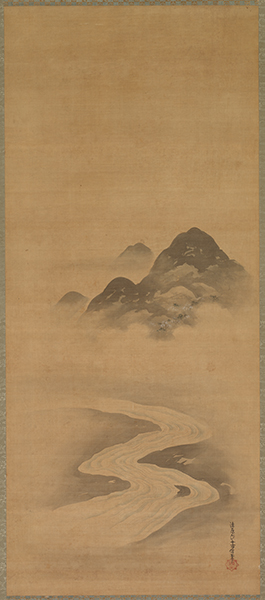Pioneer Japanese Woman Artist: Kiyohara Yukinobu
Every year when March rolls around, I start to yearn for spring. What better way to celebrate that yearning than by presenting an artwork with spring as the subject matter?
But this is not just any run-of-the-mill Japanese landscape painter (as if there were such a thing!). This artist was one of the first women to achieve professional status as an artist in 1600s Japan. In western art history, we tend to focus on European and American women artists when discussing the uneven scholarship between male and female artists. What most of us do not think about is that Japanese women faced the same hurdles in forging artistic careers as did their western counterparts.
 |
| Kiyohara Yukinobu (1643–1682, Japan), Spring Landscape, 1600s. Ink and color on silk, image only: 37 3/8" x 16 1/8" (95 x 41 cm). Cleveland Museum of Art. (CL-1003) |
From the Nara and Kofun periods (ca. 200–794 CE), Japan adopted Chinese artistic and cultural ideas. In painting this meant an emphasis on Buddhist subjects. During the 800s, Japanese painting steered away from the Tang dynasty style of painting and developed new emphasis on a variety of subjects, including landscapes, portraits, and illustrations of Japanese literature. With the introduction of Zen Buddhism in the 1000s, the Japanese once again turned to Chinese painters, particularly landscape artists, for inspiration, while subtly establishing an indigenous Japanese painting style. One characteristic that distinguished Japanese landscapes from Chinese was the simplification of form.
Kiyohara Yukinobu was the daughter of Kusumi Morikage, a master of the Kano School, a court painting school that favored Chinese inspired landscape painting. Her mother was the niece of the master Kano Tan’yu. At the time, as in the West, women were not encouraged to become artists, much less have a professional career. Kusumi apparently encouraged his daughter’s talent, giving her private lessons, and allowing her to take lessons from other Kano school painters. She was sufficiently well-connected with the art scene in Edo (Tokyo) that she achieved a successful career. Refined brushwork, meticulous detail, and an elegant figure style characterize her work.
This work reflects the reduced complexity, simplification, and suggestion that are elements of Zen Buddhism’s emphasis on spontaneity. Depth is achieved through two major shapes: a winding river and hazy mountain. Spring is alluded to far in the background in the blossoming cherry trees on the side of the mountain.


Comments